Mechanical Surface Aerators...
High- and Low-Speed Aerators...
Surface mechanical aerators consist of submerged or partially submerged impellers attached to motors mounted on floats or
on fixed structures. The impellers are fabricated from steel, cast iron, noncorrosive alloys, and fiberglass - reinforced
plastic and are used to agitate the wastewater vigorously, entraining air in the wastewater and causing a rapid change
in the air - water interface to facilitate dissolution of the air. Surface aerators may be classified according to the
type of impeller used or the speed of rotation of the impeller. Centrifugal impellers belong to the low - speed category;
the axial-flow impeller type aerators operate at high speed. In low speed - aerators, the impeller is driven through
a reduction gear by an electric motor. The motor and gearbox are usually mounted on a platform supported either by piers
extending to the bottom of the tank or by beams that span the tank. Low - speed aerators may also be mounted on floats.
In high - speed aerators, the impeller is coupled directly to the rotating element of the electric motor. High -
speed aerators are almost always mounted on floats. These units were originally developed for use in ponds or lagoons
where the water surface elevation fluctuates or where a rigid support would be impractical. Surface aerators may be
obtained in sizes from 0.75 kW to 150 kW.
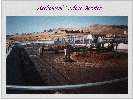

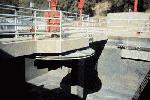
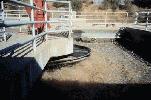
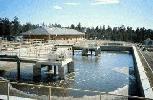
Oxygen - Transfer Rate...
Mechanical aerators are rated in terms of their oxygen - transfer rate, expressed as kilograms of oxygen per kilowatt -
hour at standard conditions. Standard conditions exist when the temperature is 20 °, the dissolved oxygen is
0.0 mg/L, and the test liquid is tap water. Testing and rating are normally done under nonsteady - state conditions
using fresh water, deaerated with sodium sulfite. Commercial - size surface aerators range in efficiency from 1.20
to 2.4 kg O2/kWh. Efficiency claims for aerator performance should be accepted by the design engineer
only when they are supported by test data for the actual model and size of the aerator under consideration. For design
purposes, the standard performance data must be adjusted to reflect anticipated field condition. This adjustment is
accomplished using the following equation.
 "Oxygen Transfer Rate"...
"Oxygen Transfer Rate"...
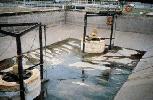
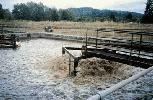
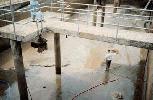

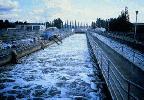
There are a wide variety of surface agitators such as paddle wheels, pumps which spray water into the air, and several other
devises. The one aspect in common with all these systems is that they all expend a great deal of kinetic energy in throwing
large quantities of water into the air. Obviously if the systems are expending energy in this task, the energy is not being
directly used to aerate or mix the water in the fish culture system. Surface agitators often look very impressive, however
their influence over the oxygen levels in the aquaculture system is rather localised to the area surrounding the equipment.
This factor becomes very apparent in ponds with a water depth of more than 1 metre. If oxygen levels are measured at depth
or in the sediment very low levels may be recorded. The low dissolved oxygen levels may lead to anaerobic sediment conditions
and deterioration in water quality.












 "Oxygen Transfer Rate"...
"Oxygen Transfer Rate"...






